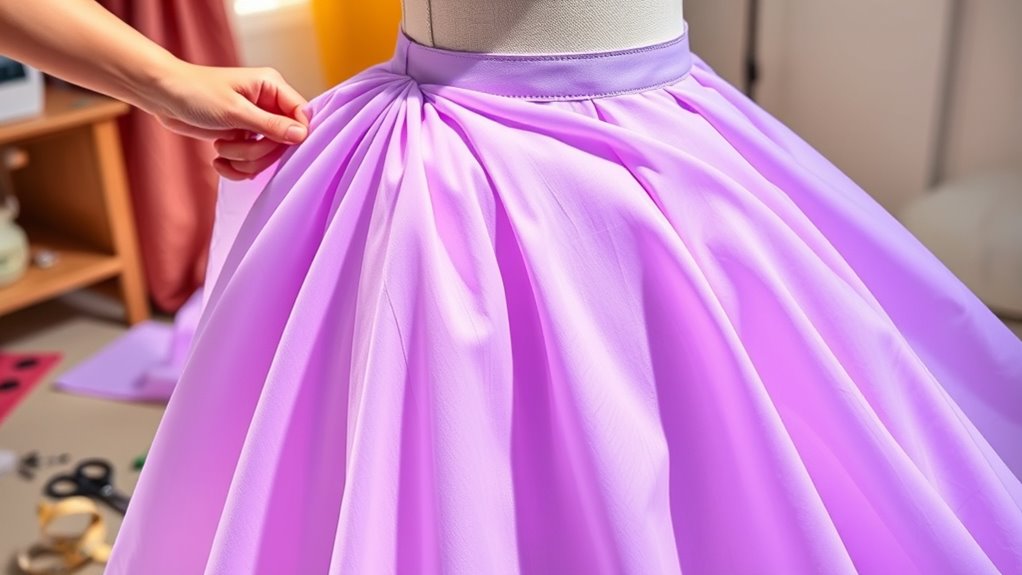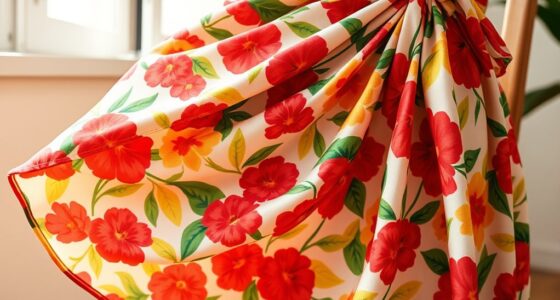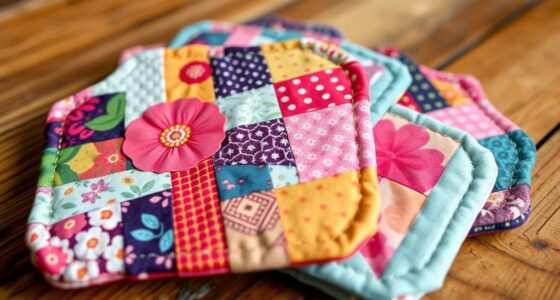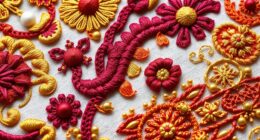To sew a circle skirt, start by choosing lightweight, drapey fabrics like cotton or chiffon that match your style. Measure your waist and skirt length, then draft a pattern with a large circle for the hem and a smaller one for the waist. Cut your fabric, sew side seams, and add an elastic or waistband for a perfect fit. Finish the hem for a smooth, twirling effect. Keep going to discover more tips for a flawless, twirly skirt.
Key Takeaways
- Select lightweight, drapey fabric, wash and iron it before pattern drafting to ensure proper fit and movement.
- Draft a large circle pattern with a smaller waist circle, then cut fabric with added seam allowances.
- Sew side seams, press open, and attach a waistband or elastic casing for a secure fit.
- Finish the hem by folding and sewing a narrow, even edge for a polished look.
- Press all seams and hems, check fit, and trim loose threads to complete your twirly circle skirt.
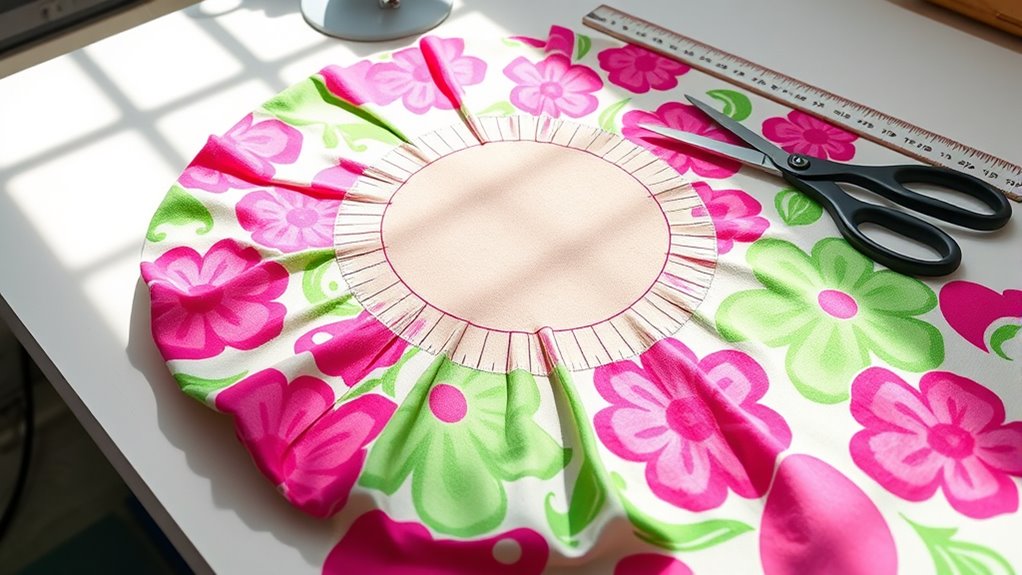
Sewing a circle skirt is a rewarding project that allows you to create a stylish, flowing garment with minimal sewing experience. One of the first decisions you’ll need to make involves fabric choices. Opt for lightweight, drapey fabrics like cotton, rayon, or chiffon to achieve that beautiful, twirling movement. These fabrics are easy to work with and hold their shape well, making them ideal for a circle skirt. When selecting your fabric, consider the color and pattern to match your style, but keep in mind that lighter fabrics tend to create a more fluid silhouette. Before you start cutting, wash and iron your fabric to prevent shrinkage and remove wrinkles, ensuring clean, precise cuts. For the best results, choose fabric that is suitable for Parks and Entertainment environments, where comfort and style are both important.
Equally important are your sewing tools, which will help you achieve a professional finish. Gather a good pair of fabric scissors to cut your fabric accurately, along with pins or fabric clips to hold pieces in place. A rotary cutter and cutting mat can make cutting smoother, especially if you’re working with larger pieces. You’ll also need a measuring tape to take precise body measurements and a clear ruler or straight edge for marking your pattern. A fabric marker or chalk is essential for drawing guidelines on your fabric without leaving permanent marks. For sewing, a sewing machine with adjustable stitch length will make your work easier, and don’t forget matching thread that blends well with your fabric color. An iron and ironing board are *essential* for pressing seams and hems, giving your skirt a crisp, professional look.
Once you’ve gathered your fabric and tools, start by taking accurate measurements of your waist and desired skirt length. Use these measurements to draft your pattern, which can be as simple as a large circle with a smaller circle cut out for the waist. Fold your fabric in half, pin your pattern to the fabric, and carefully cut around it. Remember to add seam allowances around the edges to facilitate sewing. When sewing the side seams, use a straight stitch and reinforce the stitches at the beginning and end for durability. After sewing, press the seams open, then sew a waistband or elastic casing at the top to fit your waist snugly. Finish the hem by folding the raw edge inward, pinning, and sewing a narrow hem. With patience and attention to detail, you’ll have a beautiful, twirly circle skirt ready to wear.
Frequently Asked Questions
What Type of Fabric Is Best for a Circle Skirt?
For a circle skirt, choose lightweight fabrics like cotton, silk, or chiffon, as they drape beautifully and create a twirl-worthy silhouette. Opt for fabrics with good fabric care, so your skirt stays vibrant and in shape longer. Avoid stiff or heavy materials that can restrict movement and ruin the skirt’s flow. Always check fabric care labels to guarantee easy maintenance and longevity, making your sewing project both fun and practical.
How Do I Adjust the Pattern for Different Waist Sizes?
To adjust the pattern for different waist sizes, measure your waist accurately. Then, modify the pattern by adding or subtracting width at the waistline, guaranteeing you maintain the circle’s shape. Use pattern adjustments by drawing new side seams or adding a waistband extension, depending on your needs. Always check your measurements again before cutting fabric to ensure a perfect fit, making your twirly skirt comfortable and tailored to your waist.
Can I Make a Circle Skirt Without a Pattern?
Yes, you can make a circle skirt without a pattern by choosing the right fabric and sewing tools. Pick fabric with good drape, like cotton or chiffon, and gather your sewing tools—measuring tape, scissors, and a seam ripper. Measure your waist and length, then cut a large circle for the skirt and a smaller one for the waistband. Sew the edges, attach the waistband, and you’re ready to twirl!
How Do I Add Pockets to a Circle Skirt?
To add pockets to your circle skirt, first choose pocket placement—side seams or front. Cut pocket pieces from fabric, then sew the edges, leaving the top open. Attach the pockets by sewing the edges to the skirt, ensuring they’re securely sewn along the pocket edges. Press the seams flat, and try on your skirt to check the placement. This method gives your skirt both style and functionality.
What Are Some Tips for Hemming a Circle Skirt?
Imagine your skirt’s hem as a gentle wave, ready to roll perfectly. To achieve this, use hemming techniques like a narrow bias or blind stitch for a clean finish. Always press your hem first, then sew with neat, even stitches, and finish seams with pinking shears or zigzag to prevent fraying. These tips give your circle skirt a polished, professional look that twirls with every step you take.
Conclusion
Now that you’ve learned how to sew a circle skirt, you’re ready to create a twirl-worthy piece that moves with you. Embrace your new skill, enjoy the process, and celebrate your unique style. Keep experimenting with fabrics, patterns, and lengths to make each skirt truly your own. Remember, sewing is about patience, practice, and passion—so sew with confidence, have fun with your designs, and let your creativity shine through every twirl and flare.
